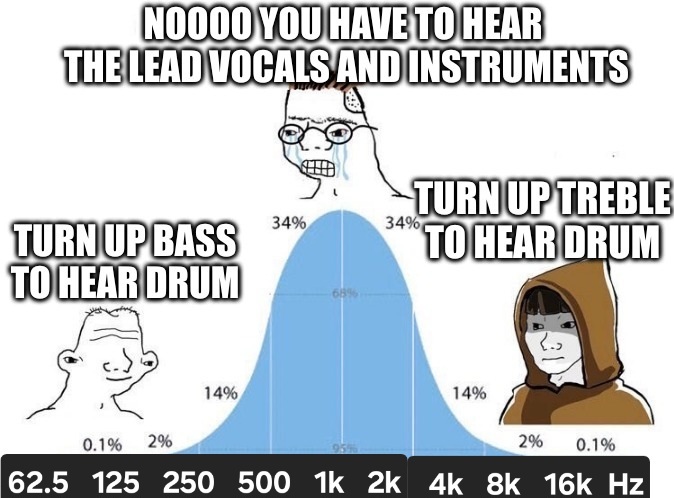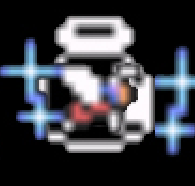I am not an audio person, so do not have much idea about technical terms - but I hear the words “bass” and “treble” almost everywhere now, especially in the equalizer app that came with a new bluetooth earbuds that I bought (yes, I am still very much a wired-earbud guy, just dipping my toes in the wireless earbud ocean).
So what do these “bass” and “treble” mean? I guess I hear the sounds to be different when I monkey around with the equalizer. The sound is slightly deep/full for “bass” and less so for “treble”.
Is that all?
Treble is the squeaky Bass is the thumpy Mids are the singers
Bass for more boom boom boom and treble for more tss tss tss
Ba dam diss…
The sound is slightly deep/full for “bass” and less so for “treble”. Is that all?
Basically, yeah.
Sounds that are lower in pitch (like the bass parts) have longer wavelengths. Any sound, whether it’s music, speech, or that annoying car alarm are just vibrations in the air made up of different wavelengths.
An equalizer can boost certain wavelengths, so when you “turn up the bass” you are amplifying the longer wavelengths but not the shorter ones.
Bass is the low pitched sound content of what you’re listening to. Treble is the high pitched content. Literally if its something that sounds high pitched to you, that’s treble. Anything in between the low pitched and high pitched content is called ‘midrange’.
A bass drum goes “boom”. A bass guitar goes “bump, bump, bump”. Those all sound like low pitched descriptions, right? A cymbal goes “crashhhhhhhhh” and a wind chime goes “twinkle, twinkle”. Both high pitched sounds. When you adjust bass or treble, you’re adjusting how loud the elements in those ranges of the audio spectrum are in the overall mix of the sounds you’re hearing in your music/media.
If the “crashhhhhhhh” is too loud and hurts your ears, turn the treble down. Similarly if the “boom” is overwhelming, turn the bass down. Just adjust them to your tastes and that’s all you need to know.
Good video on this subject: https://www.youtube.com/watch?v=I6ZF_NHvqzU
Imagine a rainbow, but it’s made of sound. That’s the audible frequency spectrum which your equalizer represents.
Bass is for low frequency sounds, so use that if you want to hear the kick drums, the bass guitar, trombone etc more clearly and you want a deep and mellow sound. Mid for human voices and most lead instruments. Treble if you want other drums and cymbals to stand out and you want a brighter but slightly shallower sound.
Eta - for those who only speak meme:

It’s in the name. The first letter of “bass” makes a low frequency sound, something that comes out of a kick drum, whereas the first letter of “treble” makes a high frequency sound, something that comes out of a cymbal.
The mids are just mid frequency sounds.
I may have oversimplified it too much.
Treble is high frequency so clicks are more pronounced, snare drums become more sharp etc.
Bass is the deep tones. Think kettle drum or something like that. When you sit next to a car in traffic and you hear that deep sound that’s annoying as hell. That’s bass.
Treble is the higher notes. Treble can also be mid range notes.
In addition to the comments made in reply to your question, something else to consider is that all loudspeakers and ears are different.
If you want to faithfully reproduce the original sound, you might need to tweak the audio using an equaliser.
If you have tiny speakers for example, you might need to amplify the lower frequencies, the bass, and suppress some of the higher frequencies, the treble, to compensate.
Deafness is not the only thing that happens to ears. For example, my ears have trouble hearing much above 2 kHz, so I often need to suppress the bass and increase the treble to make stuff properly audible, since otherwise the bass overwhelms everything and I can’t understand what a person is saying.
Finally, sound is based on vibration of air. Slow vibration makes low sounds, fast vibration makes high sounds. The speed at which the vibration happens is expressed as a frequency and the name for it is Hertz, or Hz. 1 Hz is once per second. 10 Hz, is ten times per second. 2 kHz is 2000 times per second.
That’s pretty much it, yeah. Bass is deep sounds, treble is high sounds. When you’re playing a piano, if you look at the keys, the left keys are the bottom notes and are in the bass clef. Around the middle you hit what’s called middle C and you switch to the treble clef. All of the keys have specific spots on sheet music to indicate what to play. On the equalizer app, it tries to pick out what notes and sounds are being played in the (bass/mid/treble) ranges and amplify them or mute them based on what settings you’ve picked.
In addition to giving you some control over music listening preference, these are really helpful for listening to podcasts, too. There are a few of them that are either bad at audio mixing, or they think maxing out the bass makes them sound sexy and authoritative. It really just makes them sound boomy and muddy. By cutting the bass and/or increasing the treble I can understand what they’re saying over road noise.
The equalizer simply adjusts the levels of the frequency spectrum of the sound you’re listening to. Bass pertains to lower frequencies and treble refers to the higher frequencies. The middle frequencies are appropriately called “mids”. So lowering the treble OR increasing the bass gets you more oomph and fullness, while the opposite makes it brighter and more shrill.







